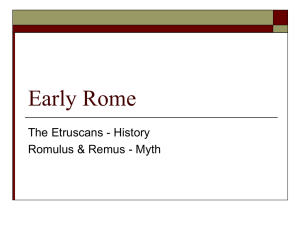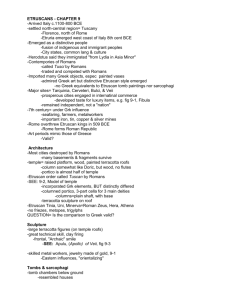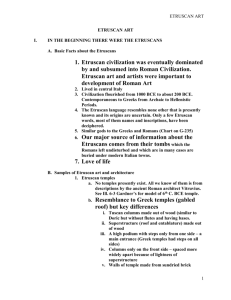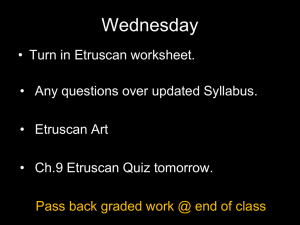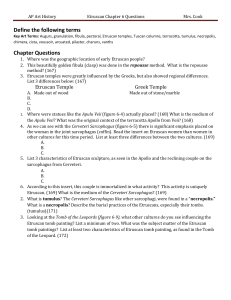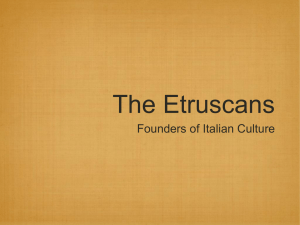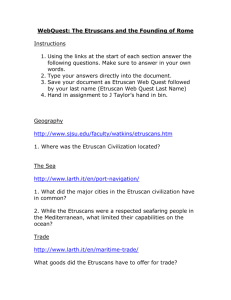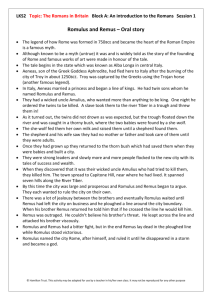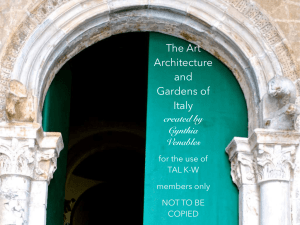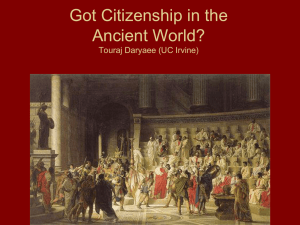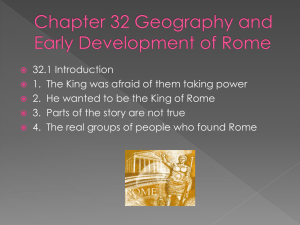The Etruscans
advertisement
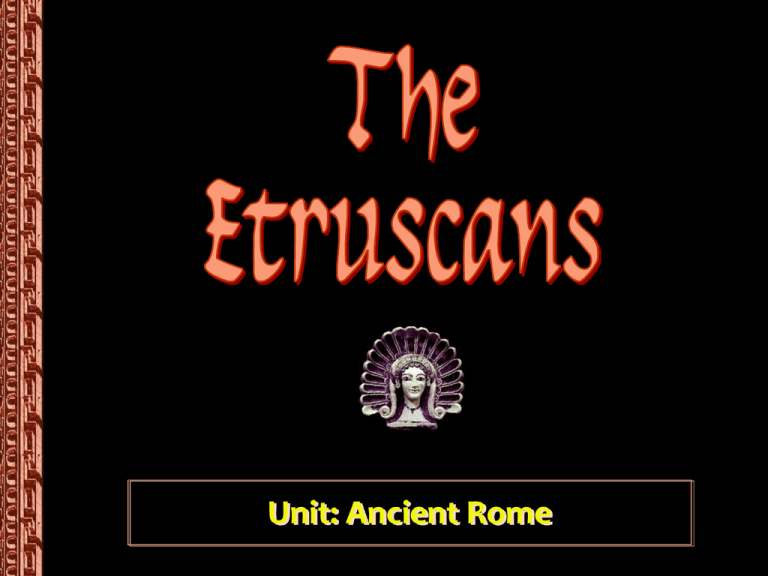
Unit: Ancient Rome ITALY MAP QUIZ FOCUS CITIES Bari Genoa Palermo Venice Milan Rome Turin Reggio de Calabria LANDFORMS/NATIONS Switzerland Sardinia Slovenia Bologna Florence Sicily San Marino PHYSICAL FEATURES/BODIES OF WATER Gulf of Taranto Gulf of Venice Gulf of Genoa Ionian Sea Ligurian Sea Strait of Sicily Adriatic Sea Mediterranean Sea Tyrrhenian Sea Strait of Messina QUIZ NEXT CLASS The Etruscans • Dominated central and northern Italian Peninsula • Confederation of city-states • Flourishing trade with the East • Alphabet based on Greek- not totally decipherable • Great respect for women The Etruscans • Influences on Rome The Arch The Vault Gladiator combat (funeral rite) Studying animal entrails Geography • Few natural resources • Although coastline extensive, few natural harbors – limited seafaring skills • Predominantly agricultural – Plains of Latium • Land open to invasion / farmersoldiers Early Greek Influences • Greek colonies on peninsula / Sicily • Influences include: Religion Alphabet Crops- grapes and olives Origin of the Etruscans Z Z Between 900 and 500 BCE Called themselves the Rasenna; >the Greeks called them Tyrrhenioi; >the Romans called them the Etruscans. Z Came from eastern Mediterranean, possibly Asia Minor. Z Their land was called Etruria. The Land of the Etruscans Etruscans Etruscan Political System Z Independent, fortified city-states. Z Formed small confederacies. Z Had a strong military that dominated all the surrounding peoples. Z By 6 C.BCE, the Etruscan military had conquered much of the Italian peninsula,including Rome and the island of Corsica. Etruscan Military Bronze Warrior 6c BCE Chariot Etruscan Writing Z Most inscriptions found on tombs and monuments and mirrors. Z We can pronounce Etruscan words, because they use an alphabet similar to Greek, but we have no clue about their meaning. Z Over 10,000 Etruscan inscriptions. Lemnos Stelae – 6c BCE The Etruscan Alphabet Etruscan Writing Tablet Etruscan Religion Z Polytheistic. Z Believed that the destiny of man was determined by the whims of the gods. Z Believed in prophecy and reading the signs of nature by augurs. Z Believed in predestination. Reconstruction of an Etruscan Temple Etruscan Cemetery Etruscan Funeral & Tomb Etruscan Tomb Wall & Tomb Fresco Interior of an Etruscan Tomb Sarcophagus of an Etruscan Couple Etruscan Gold Jewelry Life-Size Statue of an Etruscan Baby in Swaddling Clothes Etruscan Art Z Art created for religious or utilitarian purposes. Z Most famous pieces created out of terracotta. Z Many murals and frescoes on tomb walls. Z Lively depictions of life—dancing, games, music, and feasting. Z Pottery at first copies of Greek works. Later, created their own bronze pottery. Z Bronze crafts [mirrors, bowls, candelabra]. Dance Double Flutist An Etruscan Banquet Etruscan Wrestlers Etruscan Jars & Vases Etruscan Bronzes The Gate of Volterra: First known Archway in History! Tarquin [Etruscan] Rulers of Rome Reign of Romulus 753-716 BCE Numa Pompilius 715-674 BCE Tullius Hostillius 673-642 BCE Anchus Marcius 642-617 BCE Lucius Tarquinian Priscus 616-579 BCE Servius Tullius 578-535 BCE Lucius Tarquinius Superbus 535-510 BCE 509 BCE Roman Revolt Republic Established! The Origins of Rome • IndoEuropeans 2,000-1,000 BCE • City-state of Rome founded 753 BCE • Tiber River / Seven Hills of Rome • Strategic importance Tiber River / Seven Hills of Rome The Origins of Rome • Romulus and Remus • Rape of the Sabine Women Romulus and Remus Romulus and Remus Rome's twin founders Foundation myth Descendants of the Trojan prince and refugee Aeneas Fathered by Mars <or the demi-god Hercules> and Rhea Silvia Uncle exposes them to die in wild. Found by a she-wolf who suckles and cares for them. Twins are eventually restored to their regal birthright, Acquire many followers Decide to found a new city. Romulus and Remus given shelter by Pietro-da-Cortona Romulus wishes new city on Palatine Hill; Remus prefers Aventine Hill. Agree to determine the site through augury. Romulus appears to receive the sign, but each claims the truth. Tiber River / Seven Hills of Rome Disputes follow, Remus is killed. Romulus names the new city Rome, after himself Creates the Roman Legions and the Roman Senate. Adds citizens to his new city by abducting the women of the neighboring Sabine tribes, Result = combination of Sabines and Romans as one Roman people. Rome rapidly expands Rape of the Sabine Women Dominant force, due to: Divine guidance and Inspired administrative, military and political leadership of Romulus. Romulus increasingly autocratic Disappears in mysterious circumstances Deified as the god Quirinus Divine persona of the Roman people. The History of Rome • Roman history in three major political phases: The Kingdom (753-507)- Traditionally, rule by seven kings from Romulus to Tarquinius Superbus The Republic (507-31)- Rule by Senate, Consuls, Assemblies, and dictators The Empire (31 BCE – 476 CE)- Rule by emperors
